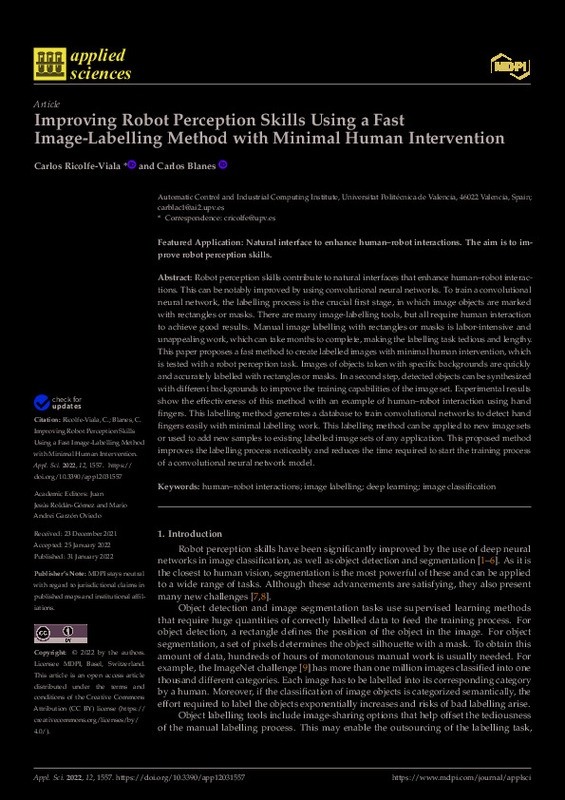JavaScript is disabled for your browser. Some features of this site may not work without it.
Buscar en RiuNet
Listar
Mi cuenta
Estadísticas
Ayuda RiuNet
Admin. UPV
Improving Robot Perception Skills Using a Fast Image-Labelling Method with Minimal Human Intervention
Mostrar el registro sencillo del ítem
Ficheros en el ítem
| dc.contributor.author | Ricolfe Viala, Carlos
|
es_ES |
| dc.contributor.author | Blanes Campos, Carlos
|
es_ES |
| dc.date.accessioned | 2023-05-29T18:02:58Z | |
| dc.date.available | 2023-05-29T18:02:58Z | |
| dc.date.issued | 2022-02 | es_ES |
| dc.identifier.uri | http://hdl.handle.net/10251/193721 | |
| dc.description.abstract | [EN] Featured Application Natural interface to enhance human-robot interactions. The aim is to improve robot perception skills. Robot perception skills contribute to natural interfaces that enhance human-robot interactions. This can be notably improved by using convolutional neural networks. To train a convolutional neural network, the labelling process is the crucial first stage, in which image objects are marked with rectangles or masks. There are many image-labelling tools, but all require human interaction to achieve good results. Manual image labelling with rectangles or masks is labor-intensive and unappealing work, which can take months to complete, making the labelling task tedious and lengthy. This paper proposes a fast method to create labelled images with minimal human intervention, which is tested with a robot perception task. Images of objects taken with specific backgrounds are quickly and accurately labelled with rectangles or masks. In a second step, detected objects can be synthesized with different backgrounds to improve the training capabilities of the image set. Experimental results show the effectiveness of this method with an example of human-robot interaction using hand fingers. This labelling method generates a database to train convolutional networks to detect hand fingers easily with minimal labelling work. This labelling method can be applied to new image sets or used to add new samples to existing labelled image sets of any application. This proposed method improves the labelling process noticeably and reduces the time required to start the training process of a convolutional neural network model. | es_ES |
| dc.description.sponsorship | The Universitat Politecnica de Valencia has financed the open access fees of this paper with the project number 20200676 (Microinspeccion de superficies). | es_ES |
| dc.language | Inglés | es_ES |
| dc.publisher | MDPI AG | es_ES |
| dc.relation.ispartof | Applied Sciences | es_ES |
| dc.rights | Reconocimiento (by) | es_ES |
| dc.subject | Human-robot interactions | es_ES |
| dc.subject | Image labelling | es_ES |
| dc.subject | Deep learning | es_ES |
| dc.subject | Image classification | es_ES |
| dc.subject.classification | INGENIERIA DE SISTEMAS Y AUTOMATICA | es_ES |
| dc.title | Improving Robot Perception Skills Using a Fast Image-Labelling Method with Minimal Human Intervention | es_ES |
| dc.type | Artículo | es_ES |
| dc.identifier.doi | 10.3390/app12031557 | es_ES |
| dc.relation.projectID | info:eu-repo/grantAgreement/UPV//20200676//Microinspección de superficies/ | es_ES |
| dc.rights.accessRights | Abierto | es_ES |
| dc.contributor.affiliation | Universitat Politècnica de València. Escuela Técnica Superior de Ingeniería del Diseño - Escola Tècnica Superior d'Enginyeria del Disseny | es_ES |
| dc.description.bibliographicCitation | Ricolfe Viala, C.; Blanes Campos, C. (2022). Improving Robot Perception Skills Using a Fast Image-Labelling Method with Minimal Human Intervention. Applied Sciences. 12(3):1-14. https://doi.org/10.3390/app12031557 | es_ES |
| dc.description.accrualMethod | S | es_ES |
| dc.relation.publisherversion | https://doi.org/10.3390/app12031557 | es_ES |
| dc.description.upvformatpinicio | 1 | es_ES |
| dc.description.upvformatpfin | 14 | es_ES |
| dc.type.version | info:eu-repo/semantics/publishedVersion | es_ES |
| dc.description.volume | 12 | es_ES |
| dc.description.issue | 3 | es_ES |
| dc.identifier.eissn | 2076-3417 | es_ES |
| dc.relation.pasarela | S\476275 | es_ES |
| dc.contributor.funder | Universitat Politècnica de València | es_ES |
| upv.costeAPC | 1623,08 | es_ES |








